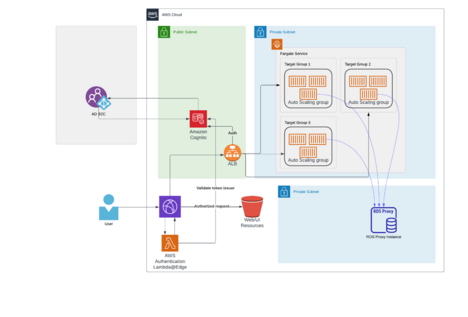
- Blog, Cloud
- Published on: 23.05.2023
- 3:25 mins
DevOps and Infrastructure as Code (IaC) as an unbeatable duo
- Managing environments in deployment code can be cumbersome
- DevOps and IaC are helpful tools on the adventurous cloud journey
- Improved collaboration and communication, faster time-to-market, and cost savings are the driving force behind DevOps and IaC
In the fast-moving world of software development, DevOps and Infrastructure as Code (IaC) have become essential tools for organizations looking to improve their agility and efficiency. Their strengths particularly come into full effect when it comes to complex cloud deployments. Let’s have a closer look at the advantages of using DevOps and IaC in continuous cloud deployments.
The Cloud Migration Example
To get a sense of the problems that may be faced, let’s consider a real-world example: The company’s IT department must migrate a solution into a cloud. The cloud environment is already explored, and the organization is running a few products in it. Excited about the new task, the IT team jumps right into the cloud console and starts putting the puzzle together, assembling products and services into a solution.
Piece by Piece
It often starts as a proof of concept for one piece of functionality followed by another – this way the solution continues to grow. During this process, many obstacles in the form of configurations, permissions, roles, and policies are tackled, and ways of “making it work” are figured out while doing so. Navigating lean and delivering in scrum, the team focuses more on results than processes. To reduce the costs for the cloud infrastructure, only minimal resources are used.
Nightmare on the Roadmap
When everything is put together and fully operational, it’s time to move it to the next environment, perhaps testing or staging. After successful tests, the solution will be deployed once again in the production environment. This is the moment of truth: In the case of having been manually recreated, the solution in every environment would quickly become a nightmare. Despite the accuracy of a deployment “playbook” the errors are inevitable.
The Heroes are Underway
This is where DevOps and IaC can shine and show off its benefits. They can increase efficiency, ensure security, save a lot of time and costs, avoiding headache on the adventurous cloud journey. First of all, DevOps and IaC improve collaboration and communication. Developers can write code that automates the deployment process, while operations teams can test and deploy code with greater ease. The results are faster feedback loops, enabling teams to identify and fix issues before they become a problem.
Faster Time-to-Market
It’s all about speed: DevOps and IaC enable teams to deploy code to the cloud quickly and efficiently. DevOps helps to automate the building, testing, and deployment process, eliminating the need for manual intervention. IaC enables teams to define and provision infrastructure in a repeatable and scalable way.
Improved Scalability and Resilience
Cloud deployments require scalable and resilient infrastructure to handle fluctuations in traffic and usage. DevOps and IaC enable teams to provision infrastructure on-demand and in a repeatable manner. This means that teams can easily scale up or down as required and ensure that their infrastructure is resilient and fault tolerant.
Increased Cost Savings
DevOps and IaC can help to save money by reducing the time and effort required for deploying and provisioning infrastructure. With automation, teams can eliminate the need for manual intervention, reducing the risk of human error and the associated costs. IaC ensures infrastructure can be provisioned in a repeatable and scalable manner.
Enhanced Security and Compliance
With DevOps and IaC, organizations improve their security posture and ensure compliance with regulations and standards. DevOps automates security testing and ensures secure code before being deployed to the cloud. IaC enables teams to define and provision infrastructure in a consistent and repeatable manner.
A typical example
A CloudFront serves a website from an AWS S3 bucket, Lambda@Edge function for authentication, Cognito as an Identity Broker and Active Directory as an Identity Provider, Serverless Fargate Service that runs business logic, Load Balancer that distributes requests to a set of target groups which are attached to auto scaling groups, Relational Database Service (RDS) with RDS Proxy for data persistence.
DevOps and IaC improve collaboration and communication, enable faster time-to-market, improve scalability and resilience, increase cost savings, and enhance security and compliance. Organizations that adopt DevOps and IaC can streamline their cloud deployment process, delivering new features and updates to their customers faster and with greater reliability.

